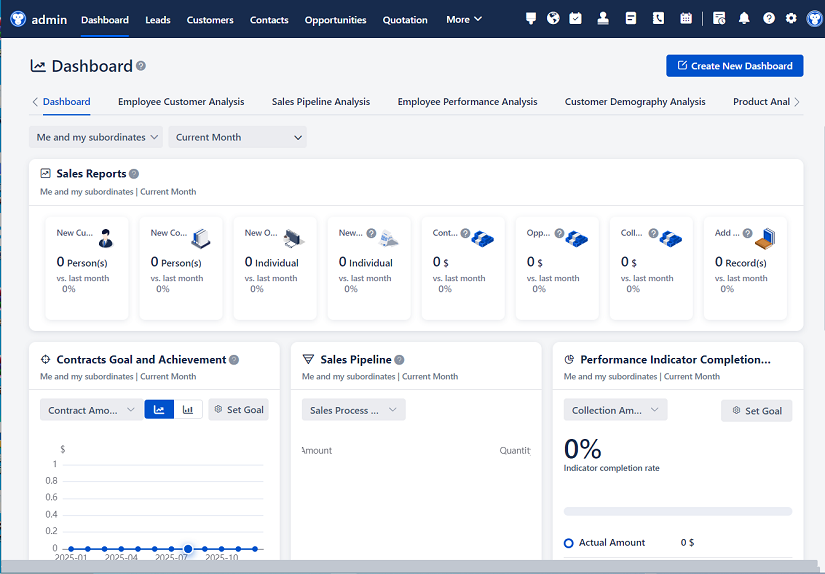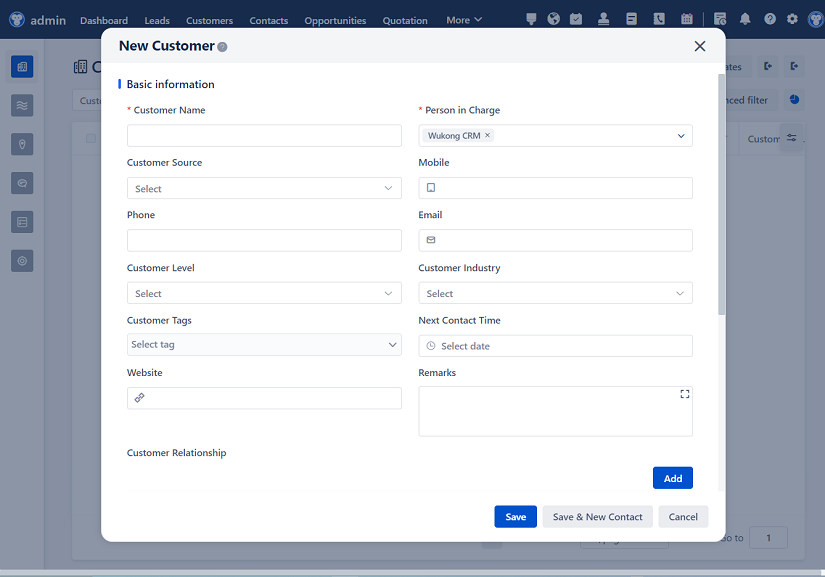
△Click on the top right corner to try Wukong CRM for free
You know, when I first started learning about CRM systems, I thought they were just fancy digital address books—places to store customer names and phone numbers. But honestly, the more I dug into it, the more I realized how wrong I was. These systems are way more powerful than that. In fact, one of the most important things they help businesses do is manage sales opportunities effectively. And that’s exactly what I want to talk about today—how companies use processes and tools within CRM systems to track, nurture, and close sales opportunities.

Free use of CRM system: Free CRM
So, picture this: you’ve got a lead—someone who’s shown interest in your product or service. Maybe they filled out a form on your website, attended a webinar, or had a quick chat with your sales rep. That’s great, right? But here’s the thing—just having a lead doesn’t mean you’re going to make a sale. What really matters is what you do next. That’s where sales opportunity management comes in.
Now, what exactly is a sales opportunity? Well, from what I’ve seen, it’s a qualified lead that has a real chance of turning into a paying customer. It’s not just someone who said “maybe”—it’s someone who’s actually engaged, has a need, and ideally, the budget and authority to make a purchase. So, once a lead hits that threshold, it gets moved into the opportunity stage in the CRM.
And here’s the cool part—CRM systems don’t just store that info. They help you manage the entire journey. Think of it like a roadmap for your sales team. You can track where each opportunity is in the sales pipeline, who’s responsible for it, what the next steps are, and even predict when it might close. It’s like having a GPS for your sales process.

But let’s be real—without a solid process, even the best CRM tool won’t help much. I’ve seen companies dump leads into their CRM and then just… forget about them. That’s a waste. A good sales opportunity management process usually starts with lead qualification. You’ve got to ask the right questions early on—like, “Do they have a pain point we can solve?” or “Are they the decision-maker?” Tools like BANT (Budget, Authority, Need, Timing) help sales reps figure this out quickly.
Once a lead is qualified, it becomes an opportunity, and that’s when things get structured. Most CRMs let you assign stages to each opportunity—like “Discovery,” “Proposal Sent,” “Negotiation,” and “Closed Won” or “Closed Lost.” This isn’t just for show. It helps everyone on the team see the big picture. You can look at a dashboard and instantly know how many deals are in negotiation, which ones are stuck, and where you might need to step in.
And speaking of dashboards—man, those are game-changers. I remember one time I was working with a small sales team, and we were all flying blind. We had no idea how many deals were close to closing, or why some kept stalling. Then we set up a proper CRM with opportunity tracking, and suddenly, everything became clearer. We could spot trends, like how long deals usually take in the proposal stage, or which reps were really good at moving opportunities forward.
Another thing I’ve noticed is that automation plays a huge role here. CRMs can automatically send follow-up emails, remind reps about overdue tasks, or even suggest the next best action based on past behavior. It’s not about replacing humans—it’s about helping them work smarter. For example, if a customer hasn’t responded in a week, the system can nudge the sales rep to give them a call. Simple, but effective.
And let’s talk about collaboration. Sales isn’t a solo sport. You’ve got marketing feeding in leads, customer support giving insights, and sometimes even finance involved in pricing discussions. A good CRM acts like a central hub where all this info lives. So when a sales rep is preparing for a meeting, they can see the customer’s entire history—past emails, support tickets, previous quotes. That kind of context makes a huge difference in building trust and closing deals.
One thing that surprised me at first was how much forecasting relies on opportunity management. Managers don’t just guess how much revenue they’ll bring in next quarter—they use data from the CRM. By looking at the value of each opportunity and its probability of closing (based on the stage it’s in), the system can generate realistic forecasts. I’ve seen teams go from wild guesses to accurate predictions just by cleaning up their opportunity data and using the CRM properly.
But here’s a challenge I’ve seen a lot—data quality. If sales reps don’t update the CRM regularly, or if they skip stages or enter fake close dates, the whole system falls apart. I once worked with a company where reps would mark deals as “Closing This Month” just to make the numbers look good—even if they knew it wouldn’t happen. That messed up forecasts and led to bad decisions. So, culture matters. You’ve got to create an environment where accurate data entry is valued, not seen as a chore.

Now, about the tools themselves—modern CRMs come packed with features. Things like drag-and-drop pipeline views, email integration, activity tracking, and even AI-powered insights. Some systems can analyze past deals and suggest which opportunities are most likely to close. Others can recommend personalized content to send to prospects based on their behavior. It’s like having a sales coach built into the software.
And don’t forget mobile access. Salespeople are on the go—they’re meeting clients, traveling, working from coffee shops. If the CRM isn’t mobile-friendly, they won’t use it. But when they can update an opportunity from their phone after a meeting, or check their pipeline during a commute, adoption goes way up.
Integration is another big deal. Your CRM shouldn’t live in a silo. It should connect with your email, calendar, marketing automation tools, and even your accounting software. When everything talks to each other, you get a complete picture of the customer journey. For example, if marketing runs a campaign and sees a spike in leads, they can track how many of those turn into real opportunities in the CRM. That helps prove ROI and align teams.
One thing I’ve learned the hard way is that not all opportunities are created equal. Some are big, complex deals that take months to close. Others are smaller, faster transactions. A good CRM lets you categorize opportunities by size, industry, product line, or any other criteria that matter to your business. That way, you can prioritize your efforts and allocate resources wisely.
And let’s not ignore the human side of all this. Technology helps, but relationships still win deals. The CRM should support the sales rep, not replace the personal touch. I’ve seen reps use CRM notes to remember little details—like a client’s kid’s name or their favorite coffee. That kind of personalization builds rapport and makes customers feel valued.
Training is crucial too. Just because you have a fancy CRM doesn’t mean your team knows how to use it. I’ve sat in on trainings where reps were confused about what to log or how to update stages. Clear guidelines and ongoing support make a huge difference. And when leadership uses the CRM themselves, it sets the tone for the whole team.
Another thing—regular reviews. I’ve found that weekly pipeline meetings, where the team goes through each opportunity, are super helpful. It’s not about micromanaging—it’s about coaching, removing roadblocks, and keeping momentum. The CRM data makes these meetings focused and productive.
And hey, let’s talk about failure for a second. Not every opportunity closes. That’s normal. But a good CRM helps you learn from the losses. You can tag why a deal was lost—price, timing, competition—and over time, spot patterns. Maybe you’re losing too many deals because of pricing. That’s valuable insight you can take to product or marketing.
Finally, I think the best part of using CRM tools for opportunity management is the clarity it brings. You’re not guessing anymore. You’re making decisions based on data. You can see what’s working, what’s not, and where to focus your energy. It reduces stress, improves accountability, and ultimately, helps you grow the business.
So, to wrap it up—sales opportunity management in CRM systems isn’t just about technology. It’s about combining the right processes, tools, and people to turn interest into revenue. It takes effort to set up and maintain, but the payoff is worth it. More closed deals, better forecasts, stronger teamwork, and happier customers. And honestly, once you’ve experienced what a well-run opportunity process feels like, you’ll wonder how you ever managed without it.
FAQs (Frequently Asked Questions):
Q: What’s the difference between a lead and an opportunity in CRM?
A: Great question. A lead is someone who’s shown initial interest—like signing up for a newsletter. An opportunity is a qualified lead that’s ready to move forward in the sales process, usually because they’ve got a need, budget, and decision-making power.
Q: How do CRM systems help with sales forecasting?
A: They use data from active opportunities—like deal size, stage in the pipeline, and historical close rates—to predict future revenue. It’s way more accurate than guessing.
Q: Can small businesses benefit from opportunity management in CRM?
Absolutely. In fact, smaller teams often see the biggest improvements because they gain structure and visibility they didn’t have before.
Q: What happens if sales reps don’t update the CRM regularly?
Well, the data becomes outdated, forecasts get inaccurate, and managers can’t make informed decisions. That’s why training and accountability are so important.
Q: Do all CRM systems have the same opportunity management features?
Not exactly. While most have basic pipeline tracking, advanced features like automation, AI insights, and forecasting tools vary by platform. It’s worth comparing options based on your needs.
Q: How can I get my team to actually use the CRM for opportunity tracking?
Start with clear expectations, provide training, lead by example, and show how it makes their jobs easier—not harder. Incentives and regular check-ins help too.
Q: Is opportunity management only for B2B sales?
Mostly, yes—because B2B sales cycles are longer and more complex. But some B2C companies with high-value products (like cars or real estate) use similar processes too.
Related links:
Free trial of CRM
Understand CRM software

△Click on the top right corner to try Wukong CRM for free